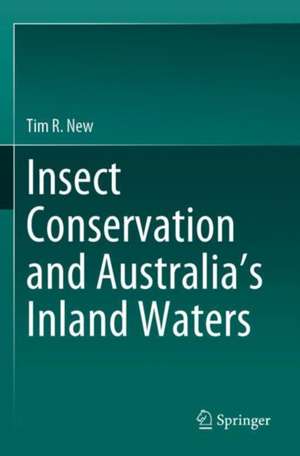Insect conservation and Australia’s Inland Waters
Autor Tim R. Newen Limba Engleză Paperback – 30 noi 2021
| Toate formatele și edițiile | Preț | Express |
|---|---|---|
| Paperback (1) | 561.49 lei 38-44 zile | |
| Springer International Publishing – 30 noi 2021 | 561.49 lei 38-44 zile | |
| Hardback (1) | 646.62 lei 3-5 săpt. | |
| Springer International Publishing – 29 noi 2020 | 646.62 lei 3-5 săpt. |
Preț: 561.49 lei
Preț vechi: 701.86 lei
-20% Nou
Puncte Express: 842
Preț estimativ în valută:
107.46€ • 111.77$ • 88.71£
107.46€ • 111.77$ • 88.71£
Carte tipărită la comandă
Livrare economică 10-16 aprilie
Preluare comenzi: 021 569.72.76
Specificații
ISBN-13: 9783030570101
ISBN-10: 303057010X
Pagini: 303
Ilustrații: XIV, 303 p. 45 illus.
Dimensiuni: 155 x 235 mm
Ediția:1st ed. 2020
Editura: Springer International Publishing
Colecția Springer
Locul publicării:Cham, Switzerland
ISBN-10: 303057010X
Pagini: 303
Ilustrații: XIV, 303 p. 45 illus.
Dimensiuni: 155 x 235 mm
Ediția:1st ed. 2020
Editura: Springer International Publishing
Colecția Springer
Locul publicării:Cham, Switzerland
Cuprins
1. Introduction: aquatic insects in Australia’s environments.- 1.1. The background to concern.- References.- 2. Major habitats.- 2.1. Introduction.- 2.2. Ponds and lakes.- 2.3. Streams and rivers.- References.- 3. Australian inland waters.- 3.1. Introduction.- 3.2. Waterfalls.- 3.3. Subterranean aquifers.- 3.4. Rock pools.- 3.5. Mound springs.- 3.6. Lakes.- 3.7. Billabongs.- 3.8. Streams and rivers.- 3.9. Exposed riverine sediments.- References.- 4. Monitoring freshwater macroinvertebrates.- 4.1. Scope and needs for assessments.- References.- 5. Threats: the background variations in condition.- 5.1. Introduction.- 5.2. Drought.- 5.3. Flood.- References.- 6. Major imposed threats.- 6.1. Introduction.- 6.2. Water temperature.- 6.3. Sedimentation.- 6.3.1. Mining.- 6.4. Pollution.- 6.5. Salinisation.- 6.6. Exploitation.- 6.7. Electrofishing.- 6.8. Changes to riparian vegetation.- 6.8.1. Emergent vegetation.- 6.9. Alien species.- 6.9.1. Plants.- 6.9.2. Fish.- 6.9.3. Mammals.- 6.10. River regulation.- 6.11. Fire.- 6.12. Urbanisation.- 6.13. Recreation.- 6.14. Ecological traps.- 6.15. Climate change.- References.- 7. Macroinvertebrates of inland waters.- 7.1. Introduction.- 7.2. The variety of aquatic insects.- 7.3. Other macroinvertebrates.- 7.3.1. Crustaceans.- 7.3.2. Molluscs.- References.- 8. Insects of Australia’s inland waters.- 8.1. Introduction.- 8.2. Ephemeroptera.- 8.3. Odonata.- 8.4. Plecoptera.- 8.5. Hemiptera.- 8.6. Coleoptera.- 8.7. Mecoptera.- 8.8. Megaloptera.- 8.9. Neuroptera.- 8.10. Lepidoptera.- 8.11. Trichoptera.- 8.12. Diptera.- 8.12.1. Control of aquatic pest flies.- References.- 9. Australia’s flagship freshwater insects.- 9.1. Introduction.- 9.2. Selected flagship taxa.- References.- 10. Ecology and management.- 10.1. Introduction.- 10.2. Dispersal.- 10.2.1. Impacts of urban lighting.- 10.2.2. Pond colonization.- References.- 11. Conservation.- 11.1. Introduction.- 11.2. Protected areas.- 11.3. Management and restoration.- 11.4. Fish conservation.- 11.5. Education and involvement.- 11.6. Artificial water bodies.- 11.7. Temporary ponds.- 11.8. Intermittent streams.- 11.9. Stormwater retention ponds.- 11.10. Refuges.- 11.11. Woody debris.- 11.12. Riparian zones.- 11.13. Perspective and prospects.- References.- Appendix 1.- Index.
Notă biografică
Emeritus Professor Tim New is an entomologist with broad interests in insect systematics, ecology and conservation. For long based at LaTrobe University, Melbourne, he has traveled widely to collect and study insects in many parts of the world, and his extensive publications on these topics include about 45 books. He is recognized globally as one of the leading advocates for insect conservation.
Textul de pe ultima copertă
The inland waters of Australia, and their largely endemic insect inhabitants, are subject to a wide and increasing variety of threats that continue to change those environments and lead to losses of insect habitats and localised taxa. Many of those changes result from human needs for water and measures to assure supply in naturally varied flood/drought regimes on which anthropogenic changes are imposed, and to which aquatic biota are increasingly susceptible. This book is a broad overview of Australian aquatic insects, the problems they face as changes to key habitats occur, and measures by which their survival may be enhanced through practical conservation. As well as summarising the current conservation interest in aquatic insects in Australia, the text draws on information and case histories from many parts of the world to augment the generally more limited information from Australian taxa and their needs, to facilitate use and perspective on conservation practice by non-specialist conservation managers, whilst also being of value to entomologists interested more directly in aquatic insect ecology and conservation .The numerous references to many taxa, regions and ecological contexts provide examples for possible emulation in Australia, and summarises many practical lessons relevant to honing effective conservation across the range from individual threatened species to the more complex protection or restoration of aquatic communities in which insects play significant functional roles.
Caracteristici
The first comprehensive overview of aquatic insect conservation in Australia, drawing on background from many parts of the world Numerous references provide much practical advice and facilitate use by both specialists and nonspecialist conservation managers Covers many different insect taxa, and emphasises the unique nature and ecological features of Australian taxa and environments, and the variety of threats they face
